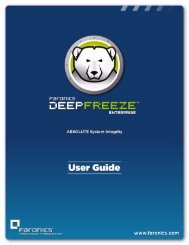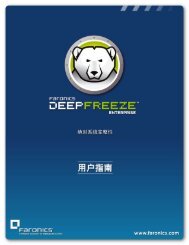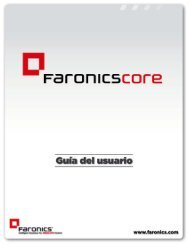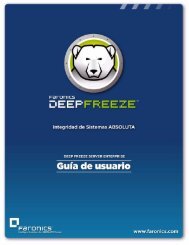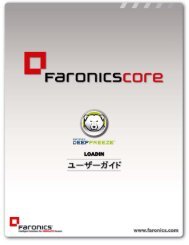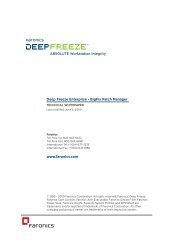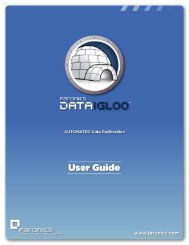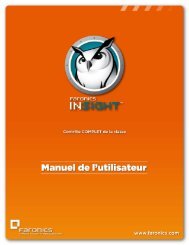Deep Freeze Enterprise User Guide - Faronics
Deep Freeze Enterprise User Guide - Faronics
Deep Freeze Enterprise User Guide - Faronics
Create successful ePaper yourself
Turn your PDF publications into a flip-book with our unique Google optimized e-Paper software.
Drives Tab| 29<br />
3. Select the ThawSpace storage unit in MB or GB.<br />
4. Select the Host Drive.<br />
— The Host Drive is the drive where the ThawSpace is created.<br />
— The storage required for the ThawSpace is used from the total storage available on the Host<br />
Drive.<br />
5. Select Visible or Hidden from the Visibility drop-down.<br />
— If you select Visible, the drive will be visible in Windows Explorer.<br />
— If you select Hidden, the drive will not be visible in Windows Explorer.<br />
— However, the hidden drive can be accessed by typing the drive letter in Start>Run.<br />
6. Click Add to add the ThawSpace.<br />
Removing a ThawSpace<br />
To remove a ThawSpace, select the ThawSpace and click Remove. The ThawSpace is removed and<br />
the drive letter is now added back to the Drive Letter drop-down. Click Remove All to remove all<br />
the ThawSpaces.<br />
Example<br />
Existing ThawSpace<br />
In the above screen, a ThawSpace of 16 MB is created on the Host Drive C: and the ThawSpace is<br />
designated with the drive letter T:. The ThawSpace T: is set to Visible and can be accessed via the<br />
Windows Explorer.<br />
The Retain existing Thawspace check box is selected by default to prevent ThawSpaces created<br />
during previous installations from being deleted.<br />
A dialog is always displayed asking if the ThawSpace should be retained or deleted during an<br />
Attended Uninstall, regardless of whether Retain existing ThawSpace has been selected. This<br />
option is not displayed if the uninstall is performed through the <strong>Enterprise</strong> Console.<br />
Always Thaw External Hard Drives<br />
Before removing a ThawSpace, remove any profile redirections or Symbolic Links.<br />
Removing a ThawSpace will also remove the data stored in it.<br />
A ThawSpace is not protected by <strong>Deep</strong> <strong>Freeze</strong>. Deploy standard data protection<br />
options such as, Anti-Virus and backup procedures.<br />
It is recommended to assign Drive Letters towards the end of the alphabet (X, Y,<br />
Z) in order to avoid automatic reassignment when a removable drive is<br />
unplugged.<br />
The Always Thaw External Hard Drives pane has two check boxes, USB and IEEE 1394<br />
(FireWire) and both check boxes are selected by default. This ensures that the USB or IEEE 1394<br />
(FireWire) hard drives are always Thawed.<br />
If the USB and/or IEEE 1394 (FireWire) external hard drives check boxes are cleared, the drive is<br />
Frozen or Thawed according to the letter each drive mounts to in the Frozen Drives section.<br />
<strong>Deep</strong> <strong>Freeze</strong> <strong>Enterprise</strong> <strong>User</strong> <strong>Guide</strong>



